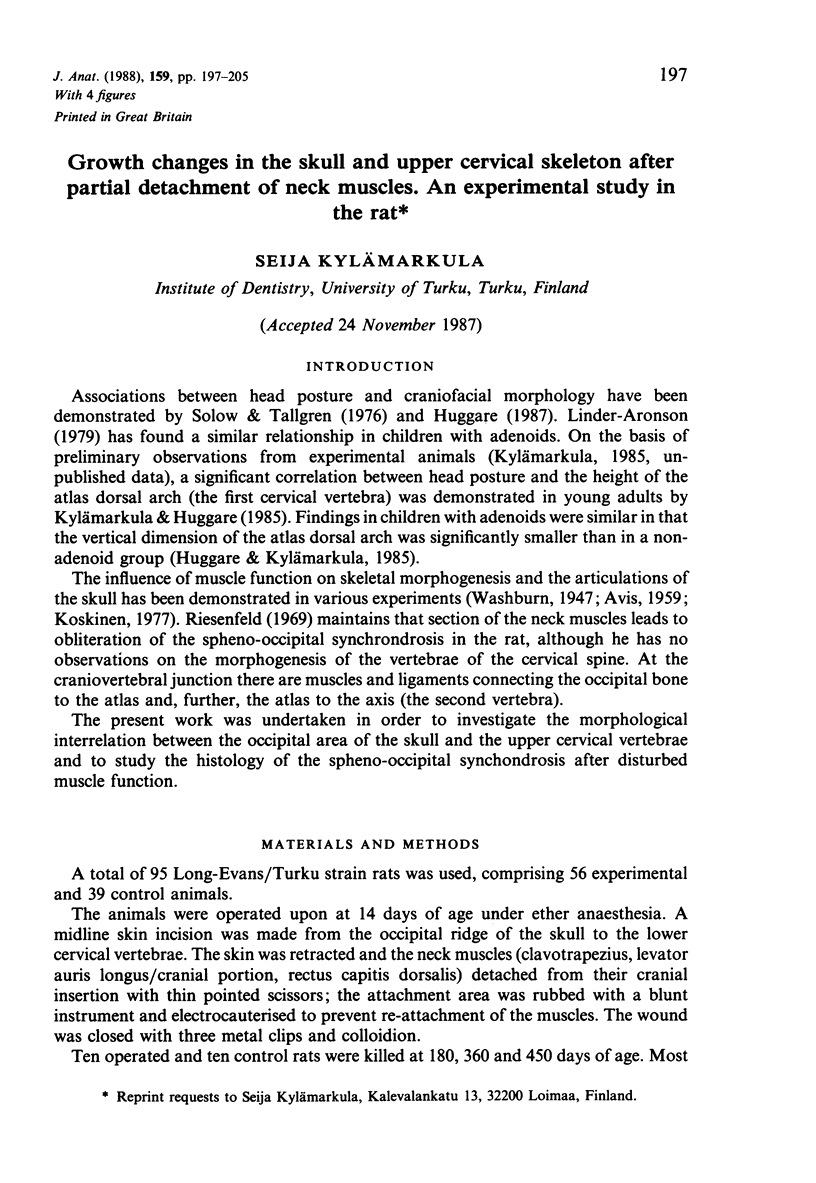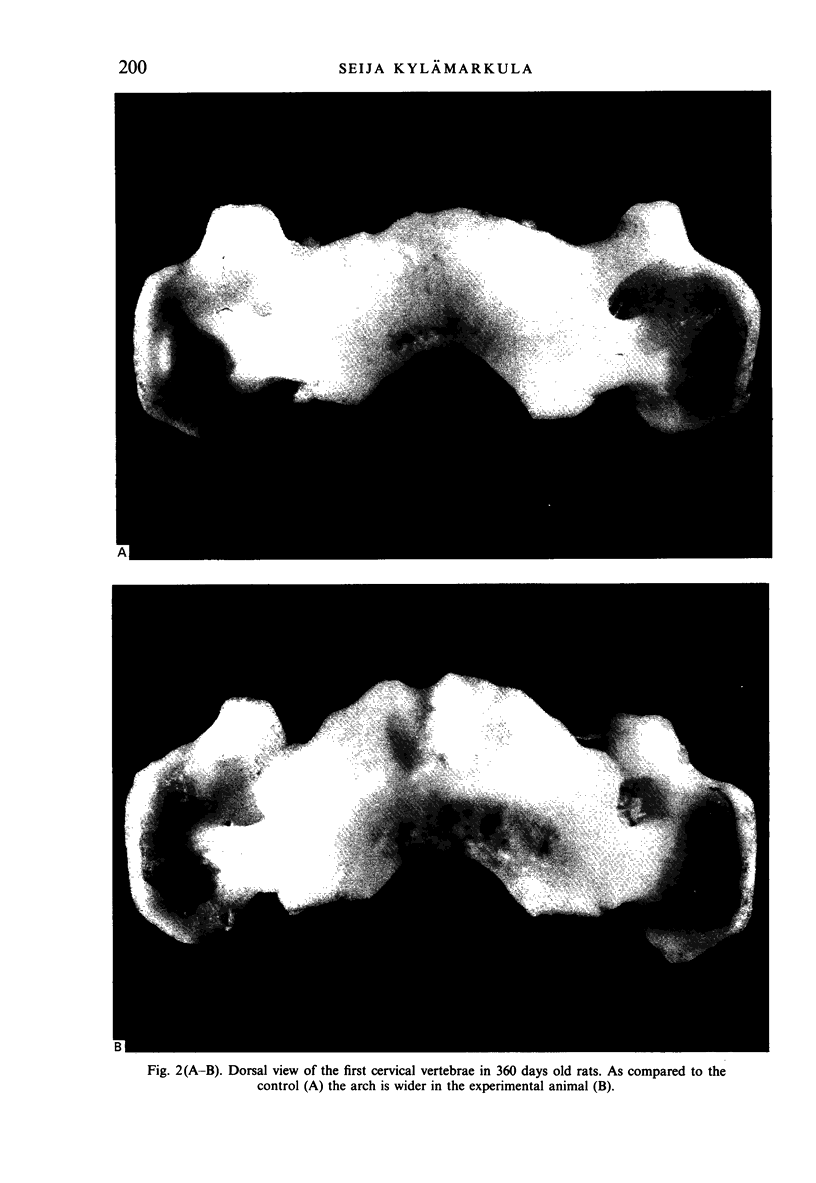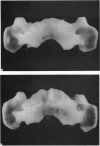Abstract
The influence of altered neck muscle function on the morphology of the craniocervical area was studied in the rat. The neck muscles were detached from their cranial attachments at 14 days of age and the skulls subjected to macroscopic, radiological and microscopic examination at 180, 360 and 450 days of age. Visual observations only were made on the three upper cervical vertebrae. As compared with the situation in the unoperated control animals, the occipital area of the experimental skull was flattened, the superior margin of the foramen magnum was irregularly curved, the sutural serration appeared less accentuated in the posterior lambdoid suture, the normally smooth curvature of which had a caudal flexture in the middle. The spheno-occipital synchondrosis was structurally similar to that in the controls, and no obliteration was seen. The angular relations between the basicranial components changed following the operation in that the posterior basicranial components at first were bent downwards while the situation was later reversed. To compensate for the upward inclination of the posterior part of the basi-occipital bone, the anterior rim of the foramen magnum had become reshaped. The downward flexion of the basicranium was considered to be the result of the decreased nuchal muscle tension whereas the reversed angle phenomenon was possibly brought about by tissue scarring. The dorsal arch of the first cervical vertebra was wider craniocaudally than in the controls and its cranial border was bent ventrally. The second vertebra differed from the controls in that the spinous process was longer and in some cases was directed upwards.(ABSTRACT TRUNCATED AT 250 WORDS)
Full text
PDF








Images in this article
Selected References
These references are in PubMed. This may not be the complete list of references from this article.
- AVIS V. The relation of the temporal muscle to the form of the coronoid process. Am J Phys Anthropol. 1959 Jun;17:99–104. doi: 10.1002/ajpa.1330170204. [DOI] [PubMed] [Google Scholar]
- Huggare J., Kylämarkula S. Morphology of the first cervical vertebra in children with enlarged adenoids. Eur J Orthod. 1985 May;7(2):93–96. doi: 10.1093/ejo/7.2.93. [DOI] [PubMed] [Google Scholar]
- KNUTSSON F. Growth and differentiation of the postnatal vertebra. Acta radiol. 1961 Jun;55:401–408. [PubMed] [Google Scholar]
- Koebke J., Brade H. Morphological and functional studies on the lateral joints of the first and second cervical vertebrae in man. Anat Embryol (Berl) 1982;164(2):265–275. doi: 10.1007/BF00318510. [DOI] [PubMed] [Google Scholar]
- Koski K. Cartilage in the face. Birth Defects Orig Artic Ser. 1975;11(7):231–254. [PubMed] [Google Scholar]
- Kylämarkula S., Huggare J. Head posture and the morphology of the first cervical vertebra. Eur J Orthod. 1985 Aug;7(3):151–156. doi: 10.1093/ejo/7.3.151. [DOI] [PubMed] [Google Scholar]
- Mestdagh H. Morphological aspects and biomechanical properties of the vertebroaxial joint (C2-C3). Acta Morphol Neerl Scand. 1976 Feb;14(1):19–30. [PubMed] [Google Scholar]
- Murray P. D., Drachman D. B. The role of movement in the development of joints and related structures: the head and neck in the chick embryo. J Embryol Exp Morphol. 1969 Nov;22(3):349–371. [PubMed] [Google Scholar]
- Rönning O., Kylämarkula S. Reactions of transplanted neurocentral synchondroses to different conditions of mechanical stress. A methodological study on the rat. J Anat. 1979 Jun;128(Pt 4):789–801. [PMC free article] [PubMed] [Google Scholar]
- Solow B., Tallgren A. Head posture and craniofacial morphology. Am J Phys Anthropol. 1976 May;44(3):417–435. doi: 10.1002/ajpa.1330440306. [DOI] [PubMed] [Google Scholar]
- Storey E., Feik S. A. Remodelling of bone and bones: effects of altered mechanical stress on caudal vertebrae. J Anat. 1985 Jan;140(Pt 1):37–48. [PMC free article] [PubMed] [Google Scholar]





